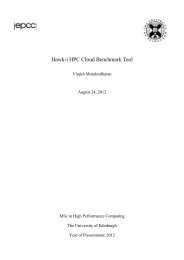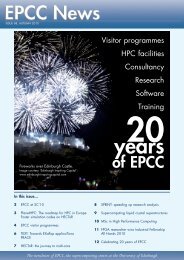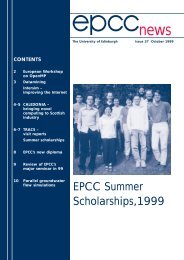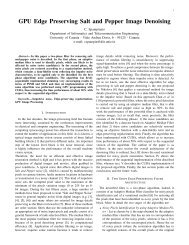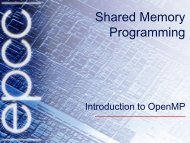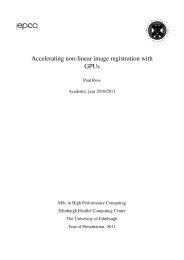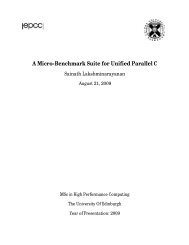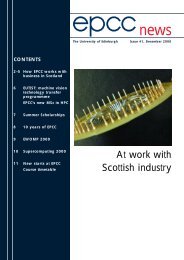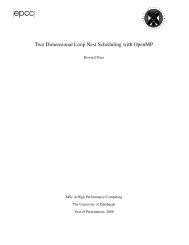Download PDF - EPCC - University of Edinburgh
Download PDF - EPCC - University of Edinburgh
Download PDF - EPCC - University of Edinburgh
Create successful ePaper yourself
Turn your PDF publications into a flip-book with our unique Google optimized e-Paper software.
FOCUS: HARDWARE<strong>of</strong> us from across the UK working in lattice gauge theoryand lattice QCD decided that the only way forward was bycollaboration, and put together a joint proposal for a bigmachine to do lattice QCD.Cray T3E (right)and T3D (below).We were awarded a grant from the Nuclear Physics Board<strong>of</strong> the Science Research Council, which funded the purchase<strong>of</strong> the Meiko i860 box, which, by the standards <strong>of</strong> the time,was quite a powerful machine. It had a peak performance <strong>of</strong>5 gigaflops – a big deal in those days!That was the first instance <strong>of</strong> a UK-wide national service, but it wasonly for one consortium?It was for one consortium, but then it was extended. We gotmore memory and a second smaller machine by collaboratingwith the Car-Parinello Consortium, led by Dominic Tildesleyfrom Southampton. This collaboration really launchedUKQCD on to the world stage and we got a lot <strong>of</strong> goodphysics out <strong>of</strong> that machine from 1990 to 1995, or so. I canstill remember coming in at Christmas and New Year andputting in Exabyte tapes in the Meiko machine to save ourdata. It was very much a string-and-sealing-wax kind <strong>of</strong>operation.So <strong>Edinburgh</strong> Parallel Computing Centre emerged as a support centrefor these consortia. And then we got the Thinking Machines’ CM-200system.Yes, the CM-200 was used by some people in UKQCD forsome <strong>of</strong> our calculations, but we didn’t have exclusive use<strong>of</strong> it, nor exclusive ownership, so it was a relatively smallcontribution to the overall computing needs that we had.They also had this wonderful data store that looked like acocktail bar: the Data Vault!Yes, we had it in the <strong>EPCC</strong> staffroom. It was huge and could hold10 GBytes. We now carry around 60 gigs in an iPod!It is absolutely staggering!Then, after the CM-200, came the Cray T3D.The T3D was funded as a national computing resource andvarious consortia bid for time on that, including UKQCD. Wemade very good use <strong>of</strong> the T3D, as we had a pretty significantallocation <strong>of</strong> time on it; however, it was a change <strong>of</strong> modelfor us. The Meiko had been very much our own baby: an inhousemachine, whilst the T3D was run as a shared resourcewith a pr<strong>of</strong>essional service. But following on from that, weconverted back to the old model, applying to PPARC fora large-scale QCD machine. A procurement exercise wascarried out and the outcome was the Cray T3E.Again, it was a shared facility among three PPARC consortia:Virgo, ourselves and the MHD Consortium. The T3E was ourmainstay for two or three years or so.There was something <strong>of</strong> a hiatus for us after the demise <strong>of</strong> theT3E. The demands on QCD were going up dramatically andwe had to be more ambitious and think on a bigger scale, andthat was the thinking that lead to the QCDOC project.We put together a bid under the JIF heading (JointInfrastructure Fund) without too much hope <strong>of</strong> success, as JIFdidn’t typically fund supercomputers. The bid was originallybased on a machine called QCDSP, designed and built inColumbia <strong>University</strong> (CU), by Norman Christ’s group. Thathad been a successful machine and a big version <strong>of</strong> it hadbeen built and installed in Brookhaven. It was based on TexasInstruments Digital Signal Processing chips with some custominterconnect.But in the meantime, Norman’s ideas became more ambitiousand he started talking with IBM. There was now an upgradedproject based around QCDOC which involved IBM andwe were funded, somewhat to our surprise. After the openThinking Machine’sCM-200 and the DataVault.Continued over.11



